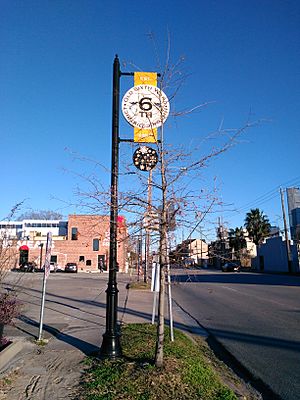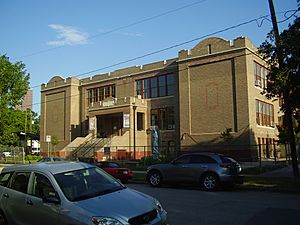Sixth Ward, Houston facts for kids
The Sixth Ward is a historic community located in Houston, Texas, United States. It's one of Houston's original historic wards, known for its unique past and beautiful old homes.
Contents
History of the Sixth Ward
The land where the Old Sixth Ward now stands was first given to John Austin in 1824. He was a close friend of Stephen F. Austin, who helped found Texas. Later, in 1836, the Allen Brothers bought this land. They were the ones who started the city of Houston.
In 1858, a man named W.R. Baker owned much of the land. He hired Samuel West to redesign the area into a system of lots and blocks, which is how the Old Sixth Ward looks today. Homes started being built around 1860. A big building boom happened about ten years later, after Washington Avenue was improved.
The Sixth Ward was officially created in 1877. It was formed from the northern part of the Fourth Ward. It's special because it's the only ward that doesn't reach into the very center of downtown Houston.
A part of the Sixth Ward was once called "Chaneyville." This name likely came from "Chaney Junction," which was the first train stop on the route from Houston to Washington-on-the-Brazos.
In 1978, the Sixth Ward Historic District was recognized as part of the National Register of Historic Places. This made it the first historic district in Harris County. People in the community have worked hard to protect the area. In 2007, some leaders even made YouTube videos to ask for more preservation. In 2008, the neighborhood celebrated its 150th birthday!
What Makes Up the Sixth Ward?
The Old Sixth Ward Neighborhood
The Sixth Ward is home to the "Old Sixth Ward," which is the oldest neighborhood in Houston that still looks much like it used to. It has the most Victorian homes in the area, besides Galveston. As of 2007, about 300 houses built between 1854 and 1935 were still standing.
The Old Sixth Ward is located just west of downtown Houston. Its borders are Memorial Drive to the south, Glenwood Cemetery to the west, Washington Avenue to the north, and Houston Avenue to the east.
This neighborhood is famous for its historic houses. It was added to the National Register of Historic Places in 1978. Then, in 1998, the Houston City Council also named it a Historic District.
Even with its historic status, some old homes in Houston can still be torn down. However, the Old Sixth Ward Neighborhood Association works hard to save these historic houses. Many homes that were once considered for demolition have been beautifully restored. In 2006, the Houston Press newspaper even called the Old Sixth Ward the "Best Hidden Neighborhood."
On August 1, 2007, the city of Houston passed a rule to protect the Old Sixth Ward. This rule helped stop more than 200 buildings from being torn down.
Vinegar Hill Area
Before the big highways were built in the mid-1900s, there was an area at the end of Washington Avenue called "Vinegar Hill." A writer named Sigman Byrd wrote about it, describing it as a "kind of arrogant slum." By 1994, Vinegar Hill had been removed.
Schools in the Sixth Ward
Students living in the Sixth Ward attend schools in the Houston ISD (Independent School District). These schools include Crockett Elementary School, Hogg Middle School, and Heights High School (which used to be called Reagan High School).
Dow Elementary School was located in the Old Sixth Ward at 1900 Kane Street. It opened there in 1912 but closed between 1991 and 1993. Today, the building is home to Multicultural Education and Counseling through the Arts (MECA), an afterschool program. MECA started leasing the building from the school district in 1993 for just $1 a year. They worked to fix up the building and eventually received ownership of it in 2004. The building also houses the Houston GLBT Community Center.
Another school, Brock Elementary, used to serve part of the Sixth Ward. It closed in 2006 and is now used as a center for young children. Students who would have gone to Brock now go to Crockett Elementary. Harper Elementary and Junior High on Center Street was the main school for Black students in the area.




